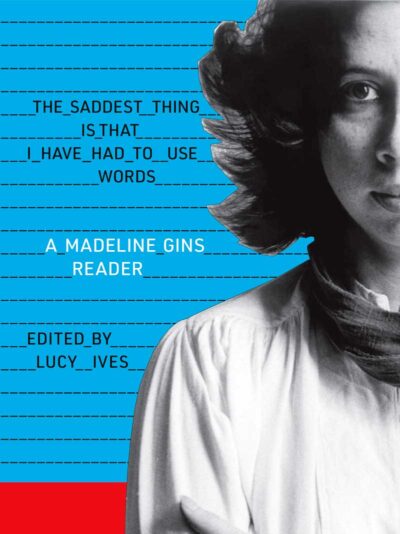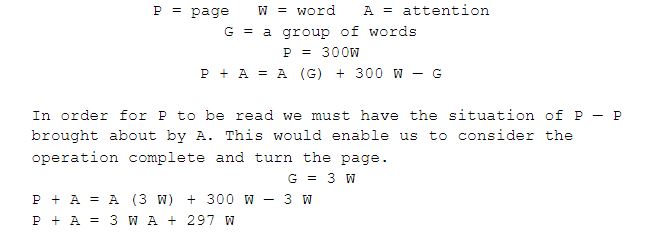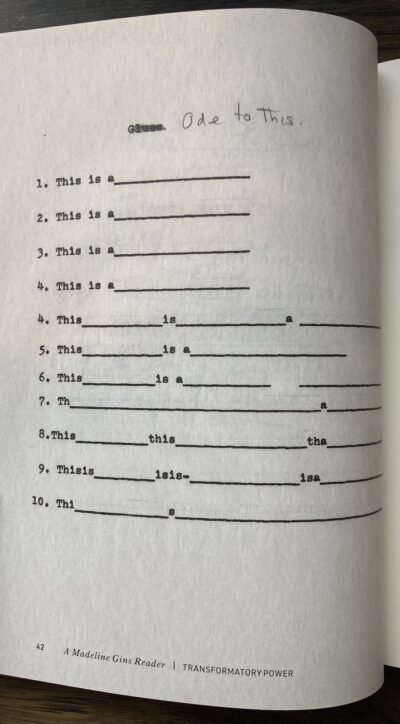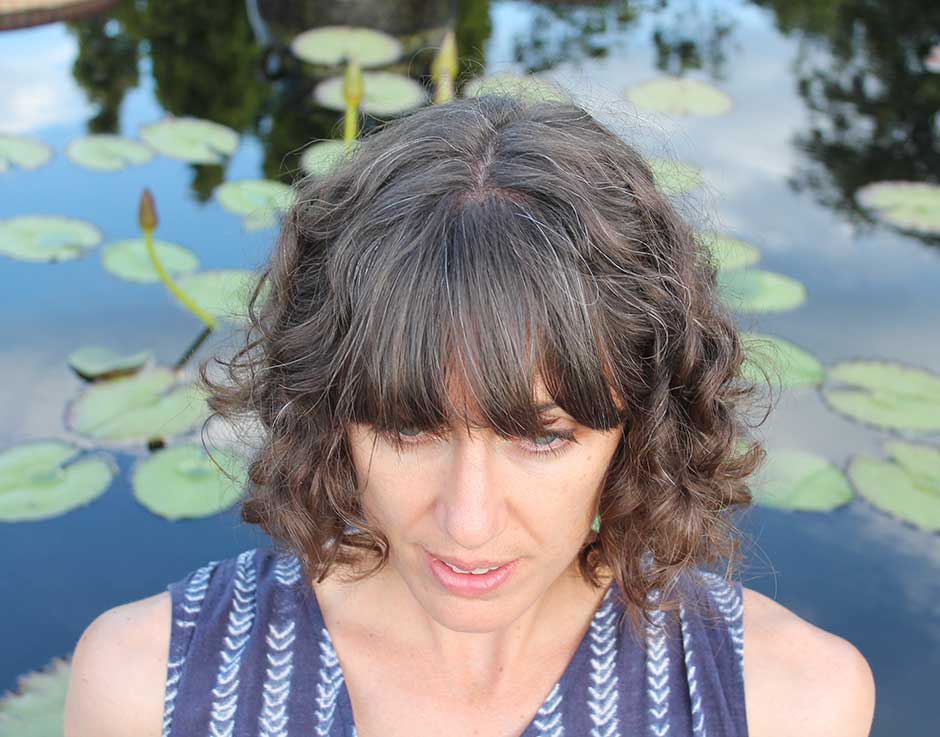Kelly Krumrie’s figuring
Tools, Typewriters, & Madeline Gins
Figuring is a monthly column that puzzles over (to figure) and gives shape to (a figure) writing, art, and environments that integrate or concern mathematics and the sciences. This month’s column explores tools, directions, and the mutable imperative of language.
Kelly Krumrie’s figuring
Tools, Typewriters, & Madeline Gins
Figuring is a monthly column that puzzles over (to figure) and gives shape to (a figure) writing, art, and environments that integrate or concern mathematics and the sciences.
In 2015, I was leading a public Montessori middle school. We had a Chromebook for each student. In August that year, before the students arrived, I locked the Chromebooks in their big metal cabinet and wheeled it into storage.[1] I bought typewriters to replace them. I searched Craigslist and met a man at a coffee shop who had to show me how to use the sky blue ‘60s-ish Royal portable. I’d never used one. He asked me how old I was. I went to flea markets. I visited a crowded typewriter and music player repair shop in Albuquerque where the owner had a dog that looked just like my dog, but his dog’s name was Suzy, and she barked from the back office. He showed me how to clean the typewriters and do minor repairs. He gave me a square of white flannel with a flower pattern; he said flannel left less lint. I laid the typewriters out on the floor of my tiny apartment and picked grime from between the type bars, polished each key, ordered fresh ribbons, got ink all over my hands. Maria Montessori thought that adolescent classrooms should have a Museum of Machines, mostly old broken things, for students to learn about, touch, use, fix. I built a set of low shelves beneath the classroom’s whiteboard. We named them: the blue one was Frank; the electric Smith Corona with cursive type was Annie; a 1930s Royal, our oldest and most expensive with a worn woven case, was Clarence; a huge green one I could hardly lift we called Biggie Smalls—I gathered about eight of them the first year. For each, I wrote sets of instructions for how to use them, how to clean them, how to change the ribbons, and I printed pdfs of the original manuals (if I could find them). I made a set of laminated cards called “Parts of the Typewriter” so when students learned how the machines worked, they could also match functions with terms like platen and paper finger.
I took the Chromebooks out because the year before the students would carry them all over the classroom. They’d be propped open in front of a student reading a book or writing on a piece of paper. What are you using it for? I’d ask. Nothing.
 What are computers for? I read Nicholas Carr’s The Shallows which is about the internet, but he begins with a history of tools. Record keeping, writing, writing instruments, farming equipment, clocks—and how these changed humans’ relationships to things and to each other, including how we think. He cites Lewis Mumford’s Technics and Civilization and others; I read these. The computer is a tool; it has a purpose. The students used computers to look stuff up, mostly, and type. If you need to use a hammer for something, you don’t carry it around with you all the time, just in case. You go get it. We had a Mac desktop, an iPad, and an iPhone. We had many books. I pointed this out. If you need to look something up, go use a tool to find the answer, then put it away. If you want to type something, you can take turns at the computer, or you can use a typewriter. They loved the typewriters, all that clacking. But they made many errors; we went through much Wite-Out. So they had to slow down, get used to the keys, be purposeful in the work, and be more okay with error.
What are computers for? I read Nicholas Carr’s The Shallows which is about the internet, but he begins with a history of tools. Record keeping, writing, writing instruments, farming equipment, clocks—and how these changed humans’ relationships to things and to each other, including how we think. He cites Lewis Mumford’s Technics and Civilization and others; I read these. The computer is a tool; it has a purpose. The students used computers to look stuff up, mostly, and type. If you need to use a hammer for something, you don’t carry it around with you all the time, just in case. You go get it. We had a Mac desktop, an iPad, and an iPhone. We had many books. I pointed this out. If you need to look something up, go use a tool to find the answer, then put it away. If you want to type something, you can take turns at the computer, or you can use a typewriter. They loved the typewriters, all that clacking. But they made many errors; we went through much Wite-Out. So they had to slow down, get used to the keys, be purposeful in the work, and be more okay with error.
This began my fascination with tools and instructions. I was always giving directions: writing out assignments, making independent work for the students, asking them to do things as the day went on, drawing processes on the whiteboard. I often asked them to write, draw, or describe instructions to demonstrate their understanding and to teach others. How do you clean the fish tank? (and with what?) How do you bisect an angle? (using a compass?) File the profit and loss report for our class business? (in what binder?) Conjugate this verb? (how do you know you’re right?)
When I left middle school for PhD school, this followed me. In a novel: a description of a machine, a character picks up a hammer, reads a manual. A fact is embedded. Someone explains something. Someone explains something to me: an imperative (think Yoko Ono). I could spiral off here in many directions (and I want to). But for now I’ll try to narrow my thinking: This is all related to mathematics—I’ll keep that part tight here—and that relationship brought me to The Saddest Thing Is That I Have Had to Use Words: A Madeline Gins Reader, edited by Lucy Ives (Siglio, 2020).
Like any good reader, The Saddest Thing contains a range of Gins’ writings, all clearly described in Ives’ introduction which is, frankly, fantastic. Gins covered a lot of ground artistically and worked within and against artistic circles, and she left piles of drafts and manuscripts. Ives traces her personal discovery of this work as well as the biographical, social, historical, and cultural swirlings around Gins in a way that creates a navigable frame. To say, when I encountered a new form in Gins’ writing, I had a schema ready thanks to Ives.
The thing I came to The Saddest Thing to find was how she uses mathematical diction and/or concepts—but this transitioned to something else for me. In brief: Gins uses math words a lot, especially geometric ones, and sometimes numbers. In her novel Word Rain, included in full in the reader, at the ends of sections, Gins creates these weird equations where she attempts (Ives points this out too) to quantify the number of words and sentences in the preceding text. For example, at the end of chapter two, we get:

In Word Rain, Gins is interested in what we “do” when we read, and, as writers, what we “do to” the reader. The novel is “about” a writer writing; she describes her surroundings and what she hears and thinks—and we read all this. The writer knows we’re reading it. Gins focuses on attention here, too, for the writer and the reader, and the “equations” above factor attention into word count. When I came upon these mathematical moments, I kept thinking to myself—like I did with the computers—what are these for? Are they actually measuring the text? Meaning: Is Gins actually measuring the text? Am I supposed to read through the equations to make sense of them? Am I supposed to plug in values for the variables? I don’t think so?
Another phrase that repeated in my brain as I read The Saddest Thing was “the feeling of measurement” from James Elkins’ Six Stories from the End of Representation when he’s writing about grid paintings by Agnes Martin, Sol LeWitt, and Marie Krane: The paintings and drawings “are not made to measure anything, just to propose that something is measured, or—to put it in affective terms—to elicit the feeling of measurement.” In a footnote in the introduction to The Saddest Thing, Ives calls Gins’ math “imaginary math” and likens it to the work of artist Hanne Darboven who often used grids, charts, and numbers and once exclaimed, “It has nothing to do with mathematics. Nothing!” Gins’ math in Word Rain, and her use of mathematical terminology in other writing collected in The Saddest Thing, has something to do with mathematics (not “Nothing!”), but I’d argue it’s just the feeling of it, the illusion or suggestion that the work can be measured.
The most fun I had reading and considering possible measures was in Gins’ writing that looks like instructions, early work, much of which is presented in facsimiles of her typewritten pages, sometimes with handwritten edits. These take the form of lists, including numbered ones, and Mad Libs-like sentences with blanks such as this one, which is my favorite:

Blanks, and em-dashes used as blanks, abound in the later works, sometimes taking up most of a page. The blanks, the lists, and especially the “This” statements above all elicit a feeling of measurement: the sentence like an equation, words filling in values, action happening (how to do things with words) between writer and reader, what I fill in (do I?), what these imperatives ask of me. But none actually measure anything, like the essay “Arakawa’s Painting, Diagram of Part of the Imagination: A Non-Fictional Working Out of Fictions (1963-64)” which is a description of Arakawa’s destroyed painting of a diagram. As an architect, I suspect Gins thought about measurement quite a bit. Rather, instead of measuring nothing, these writings are measurements of themselves: creation through calculation.
This is most apparent to me in the selection from the book What the President Will Say and Do!! which includes lists of imperatives and exclamations such as ALWAYS PLACE INFINITE SYSTEMS FACE DOWN and FAKE WALKING! and HAVE BIRDS WEAR VEILS TO LOOK LESS MYSTERIOUS!—these later infiltrating a fictional scene. Then there are sets of instructions such as “How to Breathe,” an “autobiography,” and invented definitions for words in “A Sisterly Thesaural Dictionary.” Gins’ “mathematical” and “instructional” writings[2] aren’t the same as directions telling me how to clean a fish tank, but they borrow that form, mimic and manipulate a feeling of clarity and action. It makes me wonder how writing and reading fish tank directions and writing and reading a fictional scene are different operations of the imagination. I’m also wondering about error.
We know language is a versatile tool. But even instruction, definition, and quantification are mutable. “This _________” could be anything. A number is what I say it is. In What the President Will Say and Do!!, and throughout The Saddest Thing, Gins’ written language—especially in its formal arrangements—knows what it’s for. It’s a self-reflexive tool, one aware of its patterns and actions and how these patterns and actions might be described and quantified, kind of like an excited kid typing up directions for how to use the typewriter on the typewriter, nomenclature cards sliding off with every release of the carriage.
***
One more thing, because I began this with teaching: The Saddest Thing Is That I Have Had to Use Words—though an excellent record of someone’s writing, doing the work of a retrospective, and elegantly—seems so teachable. I mean this with the highest praise. I can imagine dozens of multi-modal generative prompts for seventh graders through MFA and community workshop students, including fruitful conversations around the materiality and activity of written language. I want to call the collection a Museum of Machines.
Footnotes
1. Don’t worry: these were used by other classrooms and staff. They didn’t go to waste.
2. I know playing with these forms in art isn’t unique to Gins. Other reviews and interviews surrounding this collection, including Ives’ introduction, do a good job of branching out to others’ works, contemporaneous and not—many are linked on Siglio’s press page for the book. I wanted to keep this tight to her and to my experience of reading her.

About the Author
Kelly Krumrie‘s prose, poetry, and reviews are forthcoming from or appear in Entropy, La Vague, Black Warrior Review, Full Stop, and elsewhere. She is a PhD candidate in Creative Writing at the University of Denver where she serves as the prose editor for Denver Quarterly.